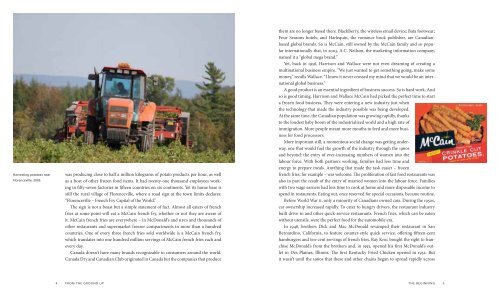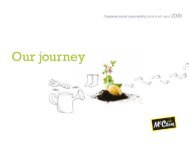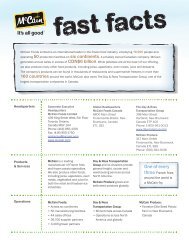From the Ground Up - McCain Foods Limited
From the Ground Up - McCain Foods Limited
From the Ground Up - McCain Foods Limited
Create successful ePaper yourself
Turn your PDF publications into a flip-book with our unique Google optimized e-Paper software.
Harvesting potatoes near<br />
Florenceville, 2005.<br />
was producing close to half a million kilograms of potato products per hour, as well<br />
as a host of o<strong>the</strong>r frozen food items. It had twenty-one thousand employees working<br />
in fifty-seven factories in fifteen countries on six continents. Yet its home base is<br />
still <strong>the</strong> rural village of Florenceville, where a road sign at <strong>the</strong> town limits declares:<br />
“Florenceville – French Fry Capital of <strong>the</strong> World.”<br />
The sign is not a boast but a simple statement of fact. Almost all eaters of french<br />
fries at some point will eat a <strong>McCain</strong> french fry, whe<strong>the</strong>r or not <strong>the</strong>y are aware of<br />
it. <strong>McCain</strong> french fries are everywhere – in McDonald’s and KFCs and thousands of<br />
o<strong>the</strong>r restaurants and supermarket freezer compartments in more than a hundred<br />
countries. One of every three french fries sold worldwide is a <strong>McCain</strong> french fry,<br />
which translates into one hundred million servings of <strong>McCain</strong> french fries each and<br />
every day.<br />
Canada doesn’t have many brands recognizable to consumers around <strong>the</strong> world.<br />
Canada Dry and Canadian Club originated in Canada but <strong>the</strong> companies that produce<br />
<strong>the</strong>m are no longer based <strong>the</strong>re. BlackBerry, <strong>the</strong> wireless email device; Bata footwear;<br />
Four Seasons hotels; and Harlequin, <strong>the</strong> romance book publisher, are Canadianbased<br />
global brands. So is <strong>McCain</strong>, still owned by <strong>the</strong> <strong>McCain</strong> family and so popular<br />
internationally that, in 2003, A.C. Neilson, <strong>the</strong> marketing information company,<br />
named it a “global mega brand.”<br />
Yet, back in 1956, Harrison and Wallace were not even dreaming of creating a<br />
multinational business empire. “We just wanted to get something going, make some<br />
money,” recalls Wallace. “I know it never crossed my mind that we would be an international<br />
global business.”<br />
A good product is an essential ingredient of business success. So is hard work. And<br />
so is good timing. Harrison and Wallace <strong>McCain</strong> had picked <strong>the</strong> perfect time to start<br />
a frozen food business. They were entering a new industry just when<br />
<strong>the</strong> technology that made <strong>the</strong> industry possible was being developed.<br />
At <strong>the</strong> same time, <strong>the</strong> Canadian population was growing rapidly, thanks<br />
to <strong>the</strong> loudest baby boom of <strong>the</strong> industrialized world and a high rate of<br />
immigration. More people meant more mouths to feed and more business<br />
for food processors.<br />
More important still, a momentous social change was getting underway,<br />
one that would fuel <strong>the</strong> growth of <strong>the</strong> industry through <strong>the</strong> 1960s<br />
and beyond: <strong>the</strong> entry of ever-increasing numbers of women into <strong>the</strong><br />
labour force. With both partners working, families had less time and<br />
energy to prepare meals. Anything that made <strong>the</strong> task easier – frozen<br />
french fries, for example – was welcome. The proliferation of fast food restaurants was<br />
also in part <strong>the</strong> result of <strong>the</strong> entry of married women into <strong>the</strong> labour force. Families<br />
with two wage earners had less time to cook at home and more disposable income to<br />
spend in restaurants. Eating out, once reserved for special occasions, became routine.<br />
Before World War II, only a minority of Canadians owned cars. During <strong>the</strong> 1950s,<br />
car ownership increased rapidly. To cater to hungry drivers, <strong>the</strong> restaurant industry<br />
built drive-in and o<strong>the</strong>r quick-service restaurants. French fries, which can be eaten<br />
without utensils, were <strong>the</strong> perfect food for <strong>the</strong> automobile era.<br />
In 1948, bro<strong>the</strong>rs Dick and Mac McDonald revamped <strong>the</strong>ir restaurant in San<br />
Bernardino, California, to feature counter-style quick service, offering fifteen-cent<br />
hamburgers and ten-cent servings of french fries. Ray Kroc bought <strong>the</strong> right to franchise<br />
McDonald’s from <strong>the</strong> bro<strong>the</strong>rs and, in 1955, opened his first McDonald’s outlet<br />
in Des Plaines, Illinois. The first Kentucky Fried Chicken opened in 1952. But<br />
it wasn’t until <strong>the</strong> 1960s that <strong>the</strong>se and o<strong>the</strong>r chains began to spread rapidly across<br />
4 <strong>From</strong> <strong>the</strong> <strong>Ground</strong> up<br />
t he BeG inninG 5






